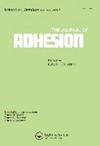将分析模型与无损评价相结合,估算退化粘结接头的残余强度
IF 2.3
4区 材料科学
Q2 ENGINEERING, CHEMICAL
引用次数: 1
摘要
与粘合剂降解相关的耐久性问题阻碍了粘接在飞机上的广泛应用,并导致了几起与粘接相关的服役事故,促进了广泛的相关研究。虽然键合线质量的无损评价(NDE)仍然难以实现,但一些作者认为,NDE可以建立键合强度阈值,支持剩余有效键合重叠(REBO)的理论概念。这些作者仅从现象学的角度将强度阈值与人工弱键试件的濒死体验联系起来。本研究提出了两种基于物理的方法,将无损检测与应力分析的分析模型相结合,以估计考虑近似REBO的环境退化金属粘结接头的残余强度。这些方法结合了两种物理上不同的濒死体验技术的基本特征和与水有关的老化机制。统计处理的实验数据验证了典型的航空应用的铝-环氧键合接头。两组接头暴露在热/湿受控环境中,以诱导具有代表性的退化,并进行不同时期的无损检测和机械测试。每组试样的不同之处只是在表面处理上导致了不同的破坏模式——粘附和内聚破坏。不同退化程度和破坏模式下的估计残余强度与准静态载荷保守一致。本文章由计算机程序翻译,如有差异,请以英文原文为准。
Estimate residual strength of degraded bonded joints by combining analytical models with non-destructive evaluations
ABSTRACT Durability issues associated with adhesive degradation have hindered widespread use of bonding in aircraft applications and contributed to several bond-related in-service accidents, fostering extensive related research. While the non-destructive evaluation (NDE) of bondline quality remains elusive, some authors suggested that NDE could establish bond strength thresholds, supporting the theoretical concept of a residual effective bond overlap (REBO). These authors related strength thresholds to NDE of specimens with artificial weak bonds only phenomenologically. This work proposes two physical-based approaches, combining NDE with analytical models for stress analysis, to estimate the residual strength of environmentally degraded metallic bonded joints considering an approximated REBO. These approaches incorporate fundamental characteristics of two physically distinct NDE techniques and a water-related aging mechanism. Statistically treated experimental data for verification was obtained from aluminum-epoxy bonded joints typical of aeronautic application. Two sets of these joints were exposed in a hot/wet controlled environment – to induce representative degradations – for different periods, non-destructively inspected, and mechanically tested. Each set of specimens differed only in the surface preparation to prompt dissimilar failure modes – adhesion and cohesion failures. Estimated residual strengths for different levels of degradation and failure modes were in agreement with quasi-static loads in a conservative fashion.
求助全文
通过发布文献求助,成功后即可免费获取论文全文。
去求助
来源期刊

Journal of Adhesion
工程技术-材料科学:综合
CiteScore
5.30
自引率
9.10%
发文量
55
审稿时长
1 months
期刊介绍:
The Journal of Adhesion is dedicated to perpetuating understanding of the phenomenon of adhesion and its practical applications. The art of adhesion is maturing into a science that requires a broad, coordinated interdisciplinary effort to help illuminate its complex nature and numerous manifestations.
 求助内容:
求助内容: 应助结果提醒方式:
应助结果提醒方式:


